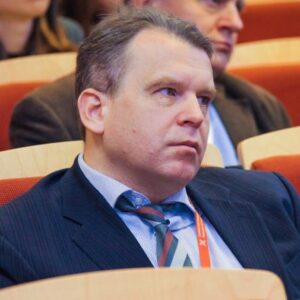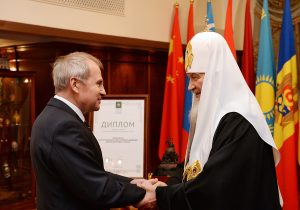
Mikhail Antonov is a professor of law associated with the Law Faculty of the National Research University Higher School of Economics in Saint Petersburg.
At the formal level, the Russian Constitution provides a standard set of antidiscrimination guarantees that are similar to many constitutions of Western countries. It proclaims Russia to be a democratic Rechtsstaat (Article 1) and enumerates a solid list of inalienable rights and freedoms in Chapter 2. In particular, Article 13 guarantees ideological diversity and prohibits any state ideology; Article 14 establishes that Russia is a secular state in which there shall be no state or obligatory religion and that religious associations are separated from the State and equal before the law.
But the reality is not as univocal as declared in the Constitution. For Russia’s first president, Boris Yeltsin, the Constitution was rather a declaratory statement needed to set forth his pro-Western ideology against the communists who fought against him in 1993. Despite its solemn provisions, the 1993 Constitution was not treated by Yeltsin and his followers as a real instrument capable of limiting their power. In short, the Constitution may formally have supreme binding force but, in fact, has been subordinated to practical political goals formulated by presidential power. To mitigate this ambivalence, in the mid-1990s, Russian ideologists began fostering a new state ideology based on narratives about Russia’s glorious past (allegedly interrupted in 1917 by the communists who were political adversaries of Yeltsin’s government in the 1990s). According to these narratives, the greatness of this past and the uniqueness of Russian culture were largely due to Orthodox Christianity.
This ideology opened the way to a mutually profitable political game between the State and the Church. Factual acceptance of this ideology by the Russian state implied that such formal constitutional principles as church-state autonomy and secularity had to be somehow circumvented. The best solution was to reinterpret the Constitution without changing its literal wording, basing this reinterpretation on historical narratives that allow for a conservative reading of liberal constitutional provisions. As articulated by Justice Nikolai Bondar, this solution required rejection of liberal “political romanticism” (the universality of human rights and freedoms) and of “empty formal legality” (the supreme legal force of the laws and constitution) in favor of “realism”—both in the legal sense of judicial discretion and in the philosophical sense of certain universalia in the spiritual constitution of the Russian people.
Using the metaphor of the deep state, one can describe the results of this reinterpretation in terms of the “deep Constitution,” which refers to the spiritual values of the Russian people. This deep level reveals the specifically national mentality and consciousness, and the religious and moral convictions, of the Russian people (in other terms, of the social majority), which are to be detected and formulated by those who have the power to decide about exceptions. This power is what Carl Schmitt called sovereignty, the political ability to impose the distinction between friends and enemies of the nation. It is not by chance that this term played a key role in political and legal narratives in Russia during recent years.
Until recently, this jurisprudence of the Constitutional Court had no anchoring in the literal text of the Constitution—apart from some vague ideas about respect to the “memory of ancestors” in the Preamble—and the courts had to justify their detours from literal constitutional and statutory texts through broad interpretation of the sovereignty doctrine. But recent constitutional amendments (the newly added Article 67.1) introduced tools that gave courts the power of unlimited interpretation of the Constitution and legalized, at least partly, this deep Constitution.
One cannot fail to notice that there will be inevitable conflict between the deep Constitution and the formal Constitution: the latter proclaims and guarantees individual rights and freedoms against the dictate of the State and of the “silent majority,” while the former allows for condemnation of these rights and freedoms as an expression of antisocial individualism. This cleavage is often underscored in political narratives in which Russian society is described as a traditionalist one, sharing common Orthodox values (as implied in the new constitutional formula of Article 67.1). This interpretation turned the Constitution into a kind of tool for memory politics.

The official teachings of the Russian Orthodox Church and the new constitutional memory politics have many points in common. Both assert that moral traditions have more weight than legal norms, and that in the case of a conflict between human rights and traditional values, the latter shall prevail. Both coordinate their efforts to resist the “sinful” effects of globalization and to reassert traditional family values. For both, this common ideological agenda brings mutual political advantages. The State can better encapsulate itself from internal and external criticism for the violation of human rights, while the Church gains symbolic capital from positioning itself as a guarantor of traditional values not only in Russia but also in the world. Not surprisingly, the State and the Church work hand in hand to promote in public discourse the conservative argumentation tools that pour water on the mill of traditional values. The Church, as evidently implied by Chief Justice Zorkin, is to be among those powerful “leaders of public opinion” who have a decisive say on matters of constitutional interpretation by determining the context of this interpretation through “informal mechanisms, reproduced by culture and tradition, that define what is considered to be obligatory and non-obligatory, good and evil, admissible and inadmissible.”
The Russian Orthodox Church’s cooperation with the Russian state is explicable on the one hand by path dependence (the historical tradition of symphonic cooperation between the Church and the State) and, on the other, by the purely opportunist interests of both. But this strategy of the Church must be erroneous, especially concerning the justification of military operations. In terms of The Ambivalence of the Sacred, the Russian Orthodox Church follows the “wrong” side of this ambivalence—the side of militant strategy and not that of peacebuilding. The Church assists the State in dividing society into friends and enemies, into the majority and minorities, benefiting from this role by stigmatizing and even purging its opponents (religious and other minorities) with the hands of the State. In doing this, the Church seems to make the wrong choice, if one evaluates its choice against the background of the principles of Christianity.
